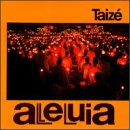| All Artists: Taize Title: Alleluia Members Wishing: 0 Total Copies: 1 Label: Gia Publications Release Date: 5/23/1995 Genres: Pop, Christian & Gospel, Gospel Style: Number of Discs: 1 SwapaCD Credits: 1 UPCs: 723722026522, 785147019428, 2605000032211, 3295750005536, 078514701942 |
Search - Taize :: Alleluia
CD Details |
CD ReviewsA Living Tradition of Contemporary Chant Timothy Kearney | Hull, MA United States | 04/14/2005 (5 out of 5 stars) "Religious chant music has become popular in the past ten or fifteen years, especially the Gregorian chants of the Benedictine tradition. Other forms of chant from the orthodox tradition are likewise experiencing resurgence in interest. Some who listen to this music, whether for relaxation or prayer, believe it is timeless, but it is also believed that it is a form of music from another era. Chant lovers can become intrigued when they discover that this ancient form of prayer is not static and a present-day Christian monastic community has developed a contemporary form of chant based largely on the chant traditions of the Benedictines and orthodox traditions, as well as modern hymns. The community that developed these contemporary chants is known as Taize and is located in France.
The music of Taize is rather simple, but it has a beauty that is derived from its ethereal feeling. The chants follow one of three basic forms. Some of the chants are simple musical notes repeated over and over, others are a refrain with verses, and others are rounds. The music corresponds with Taize's unique method of praying. The words of the chants are in a variety of languages, representing the community members from around the world, as well as the various peoples that visit the community from all over the world. ALLELUIA is similar to other Taize recordings. It contains music used in their prayer and liturgical celebrations. Some of these chants such as "Wait for the Lord" "Bless the Lord" and "Per Crucem" have become popular in liturgical worship, particularly in the Catholic tradition. While I am giving these recording five stars, it is based on the quality of the chants, not the flawlessness of the recording. One of the reasons the music of Taize is so moving is due to its being recorded live rather than in studios, which can mean imperfections. While there is little background noise, the engineering is not that advanced. Still, these slight flaws add an authentic flavor to the flavor of the recording. " |


![header=[] body=[This CD is available to be requested as disc only.]](/images/attributes/disc.png?v=15401716)
![header=[] body=[This CD is available to be requested with the disc and back insert.]](/images/attributes/disc_back.png?v=15401716)
![header=[] body=[This CD is available to be requested with the disc and front insert.]](/images/attributes/disc_front.png?v=15401716)
![header=[] body=[This CD is available to be requested with the disc, front and back inserts.]](/images/attributes/disc_front_back.png?v=15401716)